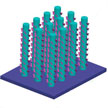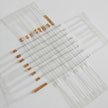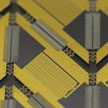Showing Spotlights 33 - 40 of 77 in category All (newest first):
 Almost all strategies for solar energy harvest and solar energy storage that exist today are developed as independent technologies. For instance, a solar cell generates electricity from the absorption and conversion of sunlight, while the storage of the produced electricity has to be implemented with another set of energy utilization solutions such as batteries/supercapacitors and fuel cells. With quite an ingenious solution, researchers have now demonstrated a hybrid, multifunctional material system that allows for simultaneous solar power generation (respectively hydrogen production), electrical energy storage, and chemical sensing.
Almost all strategies for solar energy harvest and solar energy storage that exist today are developed as independent technologies. For instance, a solar cell generates electricity from the absorption and conversion of sunlight, while the storage of the produced electricity has to be implemented with another set of energy utilization solutions such as batteries/supercapacitors and fuel cells. With quite an ingenious solution, researchers have now demonstrated a hybrid, multifunctional material system that allows for simultaneous solar power generation (respectively hydrogen production), electrical energy storage, and chemical sensing.
Jun 6th, 2014
 New solar cell technology allows your T-shirt to generate power from its interwoven solar cell wires. Researchers have developed a novel efficient wire-shaped polymer solar cell by incorporating a thin layer of titania nanoparticles between the photoactive material and electrode. An aligned carbon nanotube fiber enabled high flexibility and stability of the resulting polymer solar cell. These miniature polymer solar cell wires, when woven into textiles, can serve as a power source.
New solar cell technology allows your T-shirt to generate power from its interwoven solar cell wires. Researchers have developed a novel efficient wire-shaped polymer solar cell by incorporating a thin layer of titania nanoparticles between the photoactive material and electrode. An aligned carbon nanotube fiber enabled high flexibility and stability of the resulting polymer solar cell. These miniature polymer solar cell wires, when woven into textiles, can serve as a power source.
Apr 3rd, 2014
 Inspired by a particular folding technique called rigid origami, researchers have demonstrated foldable silicon solar cells. The fabrication process utilizes mainstream high-temperature processes to fabricate high-performance stretchable electronics. In this approach, high-performance functional devices are fabricated on rigid surfaces and do not experience large strain during deformation, and these rigid surfaces are joined by serpentine-shaped interconnects that allow for a full-degree folding and unfolding, which enables deformability.
Inspired by a particular folding technique called rigid origami, researchers have demonstrated foldable silicon solar cells. The fabrication process utilizes mainstream high-temperature processes to fabricate high-performance stretchable electronics. In this approach, high-performance functional devices are fabricated on rigid surfaces and do not experience large strain during deformation, and these rigid surfaces are joined by serpentine-shaped interconnects that allow for a full-degree folding and unfolding, which enables deformability.
Feb 26th, 2014
 Transparent and flexible substrates are widely explored for flexible electronics and researchers have been working on techniques to develop thermally stable and biodegradable materials that are as easily printable as paper. Previously, we reported on a transparent and flexible nanopaper transistor. The same team has now reported a novel transparent paper substrate design optimized for solar cells. They introduced a novel transparent paper made of earth-abundant wood fibers that simultaneously achieves an ultrahigh transmittance and ultrahigh optical haze.
Transparent and flexible substrates are widely explored for flexible electronics and researchers have been working on techniques to develop thermally stable and biodegradable materials that are as easily printable as paper. Previously, we reported on a transparent and flexible nanopaper transistor. The same team has now reported a novel transparent paper substrate design optimized for solar cells. They introduced a novel transparent paper made of earth-abundant wood fibers that simultaneously achieves an ultrahigh transmittance and ultrahigh optical haze.
Jan 22nd, 2014
 The quest for efficient low-cost solutions for solar energy conversion faces many obstacles, both, fundamental and technical. As a result, even 'ideal' solar cells have maximum intrinsic efficiency - known as the Shockley-Queisser (S-Q) limit - of 33% for the illumination by the non-concentrated sunlight. A number of architectures have been proposed for reducing losses in solar cells in order to overcome the S-Q single-junction limit. Now, researchers have proposed a new way to break the fundamental S-Q limit by using a mechanism of thermal up-conversion.
The quest for efficient low-cost solutions for solar energy conversion faces many obstacles, both, fundamental and technical. As a result, even 'ideal' solar cells have maximum intrinsic efficiency - known as the Shockley-Queisser (S-Q) limit - of 33% for the illumination by the non-concentrated sunlight. A number of architectures have been proposed for reducing losses in solar cells in order to overcome the S-Q single-junction limit. Now, researchers have proposed a new way to break the fundamental S-Q limit by using a mechanism of thermal up-conversion.
Dec 5th, 2013
 Graphene-based nanomaterials have many promising applications in energy-related areas. In particular, there are four major energy-related areas where graphene will have an impact: solar cells, supercapacitors, lithium-ion batteries, and catalysis for fuel cells. Graphene could be a promising replacement material for indium tin oxide. A recent review provides an overview of research on graphene and its derivatives, with a particular focus on synthesis, properties, and applications in solar cells.
Graphene-based nanomaterials have many promising applications in energy-related areas. In particular, there are four major energy-related areas where graphene will have an impact: solar cells, supercapacitors, lithium-ion batteries, and catalysis for fuel cells. Graphene could be a promising replacement material for indium tin oxide. A recent review provides an overview of research on graphene and its derivatives, with a particular focus on synthesis, properties, and applications in solar cells.
Oct 10th, 2013
 There is currently a tremendous amount of interest in the solution processing of inorganic materials. Low cost, large area deposition of inorganic materials could revolutionize the fabrication of solar cells, LEDs, and photodetectors. The most common methods currently used for film formation are spin coating and dip coating, which provide uniform thin films but limit the geometry of the substrate used in the process. The same nanocrystal solutions used in these procedures can also be sprayed using an airbrush, enabling larger areas and multiple substrates to be covered much more rapidly. The trade-off is the roughness and uniformity of the film, both of which can be substantially higher. Researchers have now attempted to quantify these differences for a single-layer solar cell structure, and found the main difference to be a reduction in the open circuit voltage of the device.
There is currently a tremendous amount of interest in the solution processing of inorganic materials. Low cost, large area deposition of inorganic materials could revolutionize the fabrication of solar cells, LEDs, and photodetectors. The most common methods currently used for film formation are spin coating and dip coating, which provide uniform thin films but limit the geometry of the substrate used in the process. The same nanocrystal solutions used in these procedures can also be sprayed using an airbrush, enabling larger areas and multiple substrates to be covered much more rapidly. The trade-off is the roughness and uniformity of the film, both of which can be substantially higher. Researchers have now attempted to quantify these differences for a single-layer solar cell structure, and found the main difference to be a reduction in the open circuit voltage of the device.
Sep 25th, 2013
 Using quantum dots as the basis for solar cells is not a new idea, but attempts to make such devices have not yet achieved sufficiently high efficiency in converting sunlight to power. Although these performance levels are promising, all high-performing device results to date have relied on a multiple-layer-by-layer strategy for film fabrication rather than employing a single-layer deposition process. Now, though, researchers have developed a semiconductor ink with the goal of enabling the coating of large areas of solar cell substrates in a single deposition step and thereby eliminating tens of deposition steps necessary with the previous layer-by-layer method.
Using quantum dots as the basis for solar cells is not a new idea, but attempts to make such devices have not yet achieved sufficiently high efficiency in converting sunlight to power. Although these performance levels are promising, all high-performing device results to date have relied on a multiple-layer-by-layer strategy for film fabrication rather than employing a single-layer deposition process. Now, though, researchers have developed a semiconductor ink with the goal of enabling the coating of large areas of solar cell substrates in a single deposition step and thereby eliminating tens of deposition steps necessary with the previous layer-by-layer method.
Aug 26th, 2013
 Almost all strategies for solar energy harvest and solar energy storage that exist today are developed as independent technologies. For instance, a solar cell generates electricity from the absorption and conversion of sunlight, while the storage of the produced electricity has to be implemented with another set of energy utilization solutions such as batteries/supercapacitors and fuel cells. With quite an ingenious solution, researchers have now demonstrated a hybrid, multifunctional material system that allows for simultaneous solar power generation (respectively hydrogen production), electrical energy storage, and chemical sensing.
Almost all strategies for solar energy harvest and solar energy storage that exist today are developed as independent technologies. For instance, a solar cell generates electricity from the absorption and conversion of sunlight, while the storage of the produced electricity has to be implemented with another set of energy utilization solutions such as batteries/supercapacitors and fuel cells. With quite an ingenious solution, researchers have now demonstrated a hybrid, multifunctional material system that allows for simultaneous solar power generation (respectively hydrogen production), electrical energy storage, and chemical sensing.
 Subscribe to our Nanotechnology Spotlight feed
Subscribe to our Nanotechnology Spotlight feed





